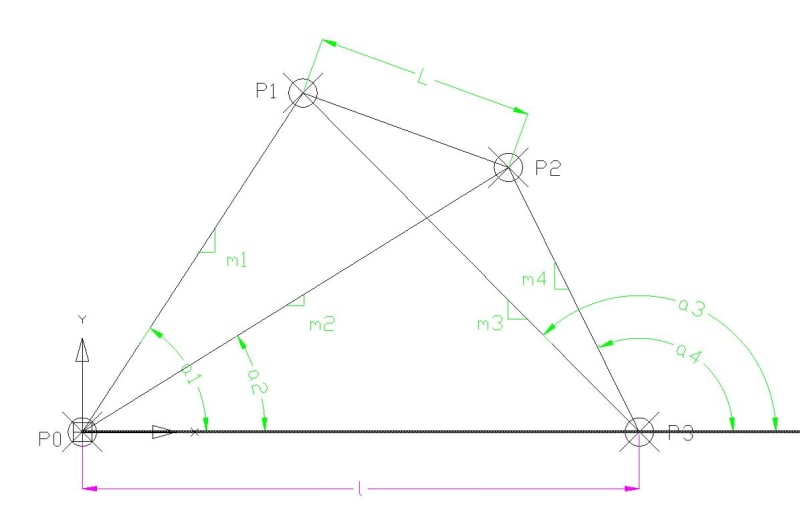Here is a topography problem that is currently stumping me.

The problem statement simple:
Given:
Find:
The real life situation is that I have two theodolites at points P0 and P3.
I also have a length of steel bar with two points (P1 and P2) marked on it for which I know the precise spacing (L). I place this bar on the ground at a suitable but unknown distance from my two theodolites.
I colimate both theodolites to establish base angle 0 deg and proceed to measure all 4 horizontal angles a1 to a4 as measured from that baseline.
Precise colimation is important here to maintain accuracy.
By calculation, I then find l.
Once I found l, I'll be able to point both theodolites on any other point Px, read the two horizontal angles and figure 2D coordinates of Px by simple triangulation.
Some of you may suggest to simply measure the distance between my theos, but I dont want to do this. Lose to much accuracy.
The next step will be to figure out the 3D solution for this problem by adding in the vertical angle readings.
Ultimate goal is to figure out 3D coords of Px.
I am sure this is a problem that has been solved many times.
So this is what ive done so far:
Write the equations of all 4 lines in the usual form y=mx+b:
Y1=m1X1+0 (1)
Y1=m3X1+b3 (2)
Y2=m2X2+0 (3)
Y2=m4X4+b4 (4)
From (2) at X=0:
l= -b3/m3 (5)
From (4) at x=0:
l= -b4/m4 (6)
From (5) = (6):
b3/b4 = m3/m4 (7)
From (1) = (2):
(m1-m3)X1 = b3 (8)
From (3) = (4):
(m2-m4)X2 = b4 (9)
Plug (8) and (9) in (7):
X1/X2 = [m3(m2-m1)] / [m4(m1-m3)] (10)
So now down to 1 equation (10) and 2 unknowns (X1, X2).
Try introducing L:
L2 = (X2-X1)2 + (Y2-Y1)2 (11)
Now have 2 equations: (10) and (11), 4 unknowns: X1, Y1, X2, Y2.
So adding in a bit of trig:
X1 = l1 Cos(a1) (12)
Y1 = l1 Sin(a1) (13)
l-X2 = l4 Cos(a3) (14)
Y2 = l4 Sin (a3) (15)
Now have 6 equations: (10) to (15), 7 unknowns: X1, Y1, X2, Y2, l1, l4 and l.
Still short 1 equation to be able to solve...
I've looked at introducing scalene triangle rules (Law of cosines, Law of sines) but that just seems to add more and more unknowns (lengths).
I believe I am missing an obvious equation to tie everything together.
Any suggestions anyone?
Thanks and Happy Holidays!

The problem statement simple:
Given:
Angles a1 to a4 (or slopes m1 to m4, same thing)
Distance L
Find:
Distance l
The real life situation is that I have two theodolites at points P0 and P3.
I also have a length of steel bar with two points (P1 and P2) marked on it for which I know the precise spacing (L). I place this bar on the ground at a suitable but unknown distance from my two theodolites.
I colimate both theodolites to establish base angle 0 deg and proceed to measure all 4 horizontal angles a1 to a4 as measured from that baseline.
Precise colimation is important here to maintain accuracy.
By calculation, I then find l.
Once I found l, I'll be able to point both theodolites on any other point Px, read the two horizontal angles and figure 2D coordinates of Px by simple triangulation.
Some of you may suggest to simply measure the distance between my theos, but I dont want to do this. Lose to much accuracy.
The next step will be to figure out the 3D solution for this problem by adding in the vertical angle readings.
Ultimate goal is to figure out 3D coords of Px.
I am sure this is a problem that has been solved many times.
So this is what ive done so far:
Write the equations of all 4 lines in the usual form y=mx+b:
Y1=m1X1+0 (1)
Y1=m3X1+b3 (2)
Y2=m2X2+0 (3)
Y2=m4X4+b4 (4)
From (2) at X=0:
l= -b3/m3 (5)
From (4) at x=0:
l= -b4/m4 (6)
From (5) = (6):
b3/b4 = m3/m4 (7)
From (1) = (2):
(m1-m3)X1 = b3 (8)
From (3) = (4):
(m2-m4)X2 = b4 (9)
Plug (8) and (9) in (7):
X1/X2 = [m3(m2-m1)] / [m4(m1-m3)] (10)
So now down to 1 equation (10) and 2 unknowns (X1, X2).
Try introducing L:
L2 = (X2-X1)2 + (Y2-Y1)2 (11)
Now have 2 equations: (10) and (11), 4 unknowns: X1, Y1, X2, Y2.
So adding in a bit of trig:
X1 = l1 Cos(a1) (12)
Y1 = l1 Sin(a1) (13)
l-X2 = l4 Cos(a3) (14)
Y2 = l4 Sin (a3) (15)
Now have 6 equations: (10) to (15), 7 unknowns: X1, Y1, X2, Y2, l1, l4 and l.
Still short 1 equation to be able to solve...
I've looked at introducing scalene triangle rules (Law of cosines, Law of sines) but that just seems to add more and more unknowns (lengths).
I believe I am missing an obvious equation to tie everything together.
Any suggestions anyone?
Thanks and Happy Holidays!
